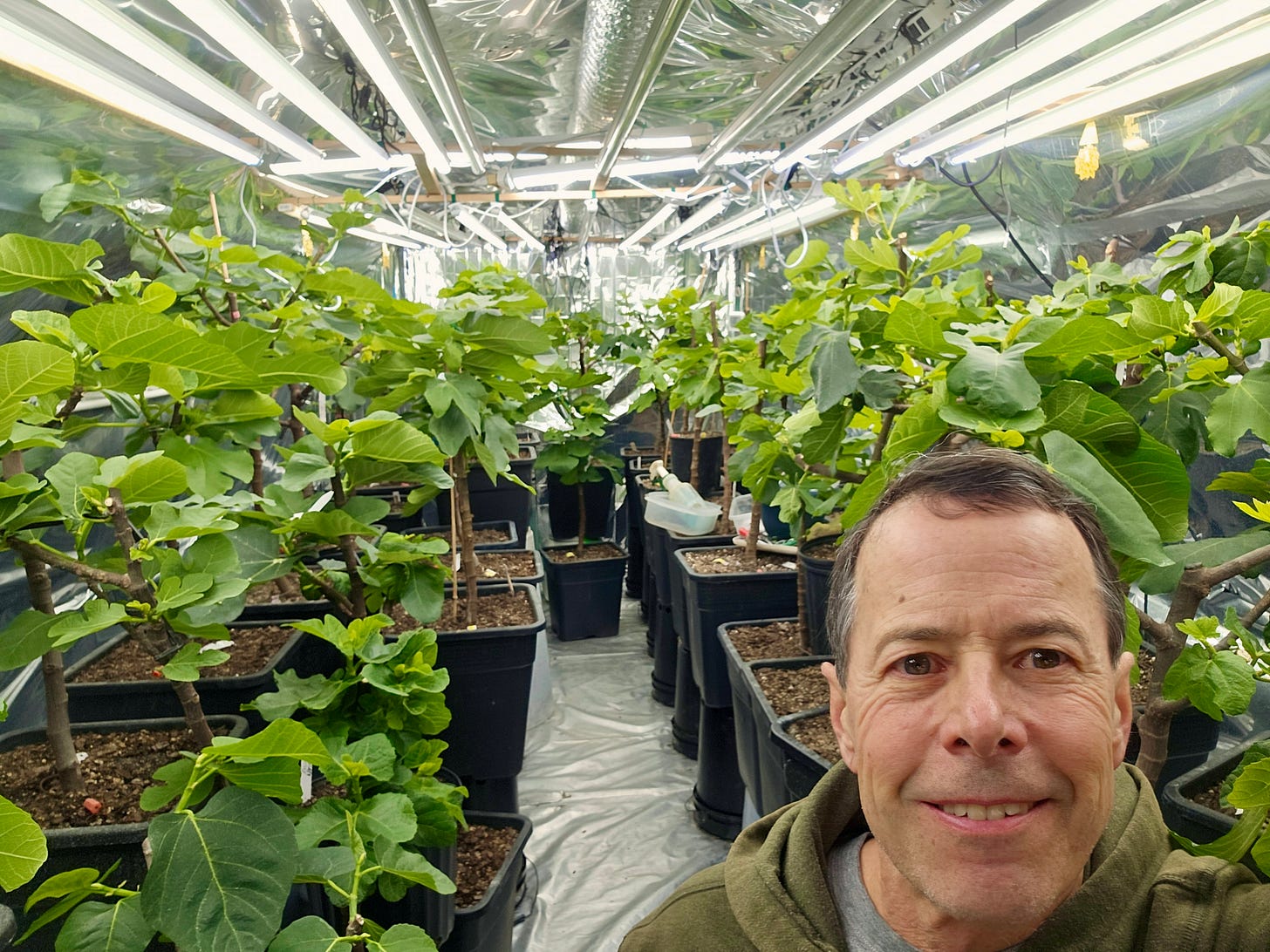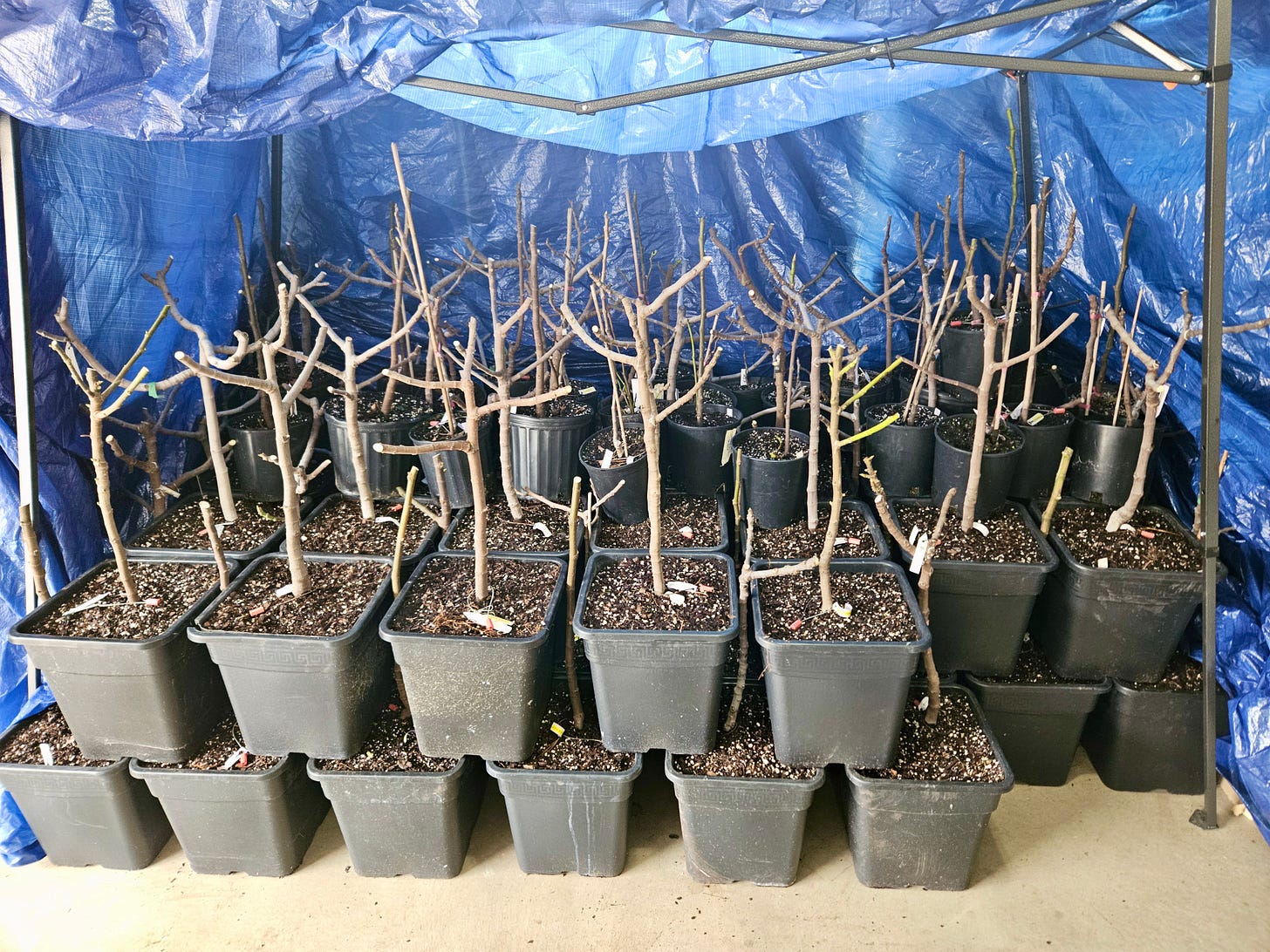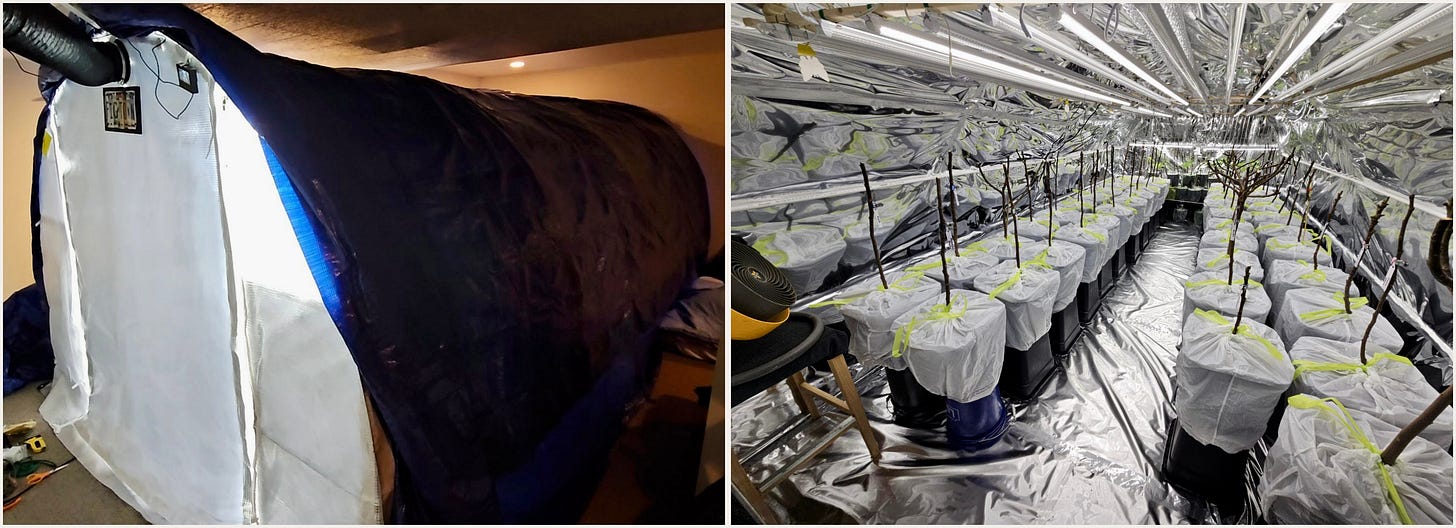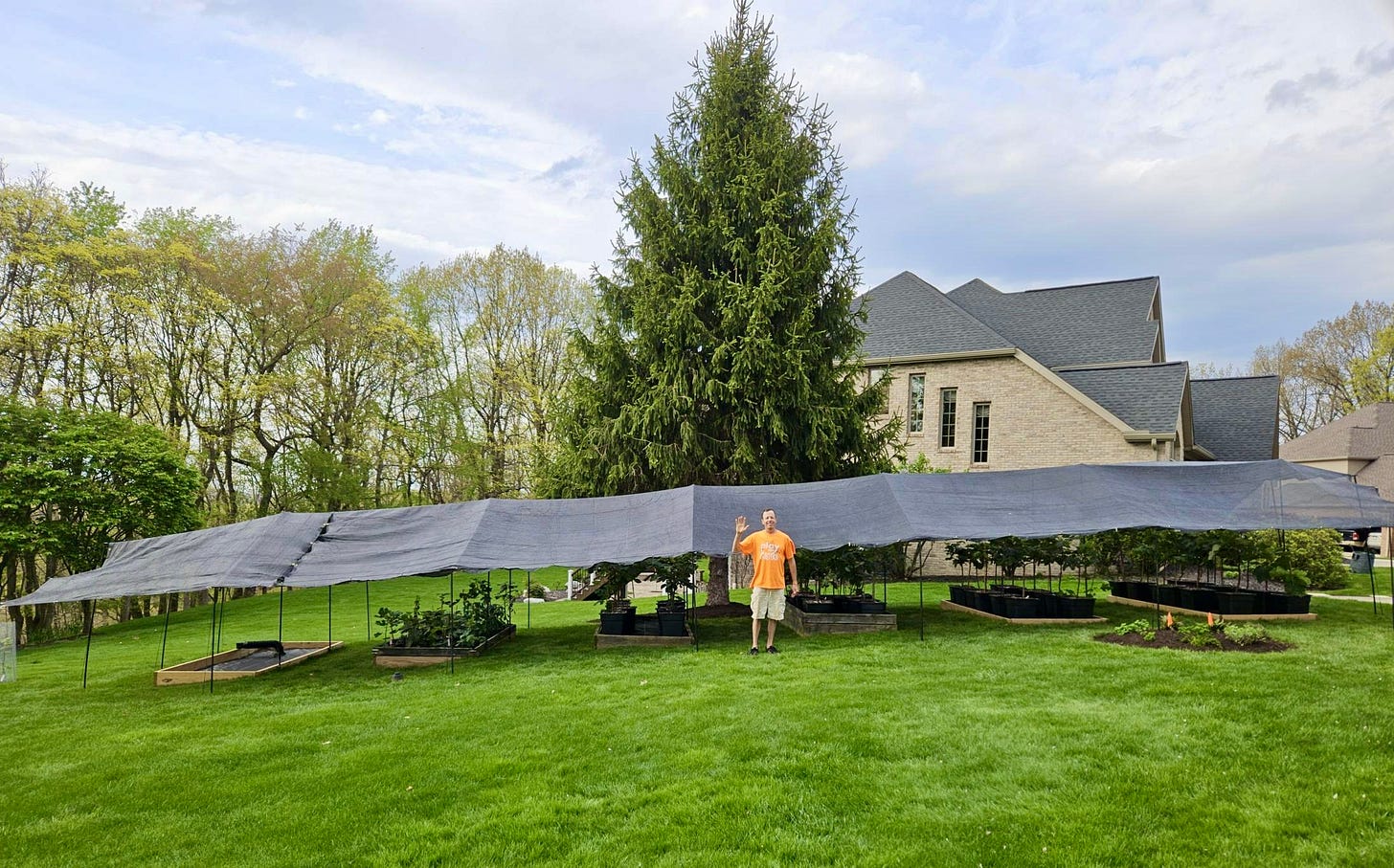Interview With A Fig Grower: Dean Pomerleau
Want to know about growing figs in colder locations with shorter growing seasons? How to do a headstart so you can taste all the varieties? Read on, fig friends!
Hey, everyone! I want to introduce a new series I am starting that interviews other fig growers from around the world. There are many perspectives and different methods of growing other than my own, including some great zone pushers out there. I want to share their stories with you so you can get to know them as people and growers. I am honored that they have taken the time to write a bit about themselves for my little newsletter and can’t wait to share everything with you. To kick things off, we have Dean Pomerleau with us telling us a little about himself and how he grows. Take it away, Dean!
Location & growing zone: Pennsylvania, 6B
My name is Dean and I'm a 60-year old retired computer guy who lives in a suburb 30 minutes north of Pittsburgh Pennsylvania. The most notable thing about my background is that I was involved in the early days of self-driving cars. For you geeks, I did my PhD in 1992 on teaching an autonomous car to drive using a camera hooked up to an artificial neural networks that you can see here.
In the 30 years since then, (and 20 years since I was actively involved in that research,) the technology has come a long way. Now it only occasionally messes up big time. 😄
One other fun fact, one of my pet fishes holds the Guinness World Record for the pet fish with the most tricks. Here is a video clip of my goldfish, Comet, in action:
I've been an avid gardener since my wife, two kids and I moved to our current home 20 years ago. Since then I've been gradually trying to turn my yard into a food forest without my neighborhood HOA noticing.
These are some of the other trees and plants in my food forest:
Pennsylvania Golden Pawpaw
Issai Hardy Kiwi Bushes
American Persimmons
Asian Persimmons
Dwarf Everbearing Mulberry
Viking Aroniaberry
Gooseberry
Jostaberry
Honeyberry
Pink Lemonade Blueberry
Wild Jujube (Jhahrberi) Tree - from seed from Indian market, indoors in pots
Red Maples - Seedlings for twin trunk bonsai in pot
Pearl Glam Beautyberry Bush
Nishiki Toyo Flowering Quince
Bush Cherry
Meiwa Kumquat Tree
Honey Jar Jujube Tree
Carmine Goumi Berry
Saskatoon Serviceberry
Marionberry
Jewel Black Raspberry
American Cranberry
Elderberry
Red Mulberry
One year, I harvested over 100 lbs of pawpaws off my single, 7-year-old, 12-foot pawpaw tree, thanks to hand pollination. About half, I gave away to friends and family. About a quarter, I ate fresh over around 45 days, (they last longer in the fridge than people say,) and the other quarter, I removed the flesh, froze it, and then vacuum-sealed to add to smoothies over the winter.
I also grow big patches of dahlias, sunflowers, hydrangeas, cannas, and a magnolia tree in the front yard to keep my wife from protesting too much about the money and time I spend on my fruiting trees and bushes.
How did you get into figs?
I was looking for new varieties of fruit trees and bushes to add to my suburban food forest a few years ago when I stumbled across figs. I spent weeks watching early Ross videos (when his videos actually contained useful information...) until I learned about the Ourfigs community.
I currently have somewhere in the neighborhood of 100 fig trees - with 85 different varieties. I grow mostly in pots since it is tough to grow figs in-ground in 6A. But last spring I did plant three early varieties in-ground as an experiment - Ronde De Bordeaux, Florea, and Pastiliere. I protected them over the winter with leaves, carpet padding, and two layers of tarp. However, we did get down to about -6°F for an extended period over the winter. After uncovering them I'm afraid all three may have died back to the ground. But we'll see as the spring progresses...
As for my potted trees, most of them are in 8-gal square pots, which I find to be a good size. They are small enough to move around without too much effort but big enough to yield a respectable harvest of 50-70 figs per tree. They also stack neatly in my garage for over-wintering.
If you want to be successful growing high-quality, top-tier figs in 6a you really need to find a way to give them a headstart. Otherwise you'll be disappointed with all the unripe figs left on your trees when the frost hits at the end of the season.
How do you headstart your trees?
I keep my trees small enough so I can give them a couple of months headstart in my basement grow room, which is critical for giving late season varieties a long enough growing season to ripen here in 6B.
Last year, I woke my trees up on February 1st by moving them to my basement grow room which is a 20x10x6.5ft greenhouse lined with 6-mil mylar. Inside are about 1960 watts of LED lights, hung 5'8" off the floor, just high enough for me to walk under.
As a rule of thumb, I'd say it takes between 10 and 14 days of around 70°F temperature for fig trees to go from dormant to breaking bud. Within 8 weeks, I have good growth and breba formation. The goal is to move them out by early to mid-May when outside temperatures are sufficiently warm. I try to time it so that the bulk of the main crop of my mid-season figs will begin ripening mid-June and late season figs starting in mid-July when the temperatures are really starting to warm up. September starts to cool off and be rainy here - not optimal for ripening. I want to have a great season by early September and any figs after that are a bonus third crop!
The trickiest part is transitioning them outside after growing them indoors for a couple months. Last year, they were moved out after 3 months in the grow room once the weather forecasted highs in the 70s or 80s and lows in the 50. I put them under 50% shade cloth for about 4-5 days to help acclimate them to the sun. Each day, I gradually increased their exposure to direct sun and decreased their time under the shade cloth.
Any tools you can’t live without?
I'm one of those people (usually guys...) who hate to make multiple trips if I can help it. My favorite tool is my custom Shufflemobile. With it, it's easy to move a dozen potted trees in a moment’s notice. Another tool that I find really valuable - my Fogcraft atomizing sprayer for applying sulfur and insecticidal soap for mite prevention. I just used sulfur and insecticidal soap in my Fogcraft sprayer prophylactically today in my basement grow room to prevent spider mites and fig mites from impacting my trees. I use it every couple weeks during the summer to spray all my fig trees with the same combination.
What are your joys and frustrations in growing figs?
I get the biggest kick out of sharing well-ripened figs with friends and neighbors. Most of them have never tasted a fresh fig and those who have usually have only tasted underripe figs from the supermarket. They are blown away when they first experience what a well-ripened fig tastes like and it is fun to see the look on their faces.
I'd have to say my biggest frustration has been losing too many figs to raccoons and squirrels. My yard borders on a big forest so there is an endless stream of wild critters streaming through my yard during the summer. It is a constant battle trying to keep them away from figs and other fruit. I've found decoys (colorfully painted golf balls hung in my trees) and organza bags to be reasonably effective, but it is always frustrating to lose fruit you've been watching ripen for a week or more.
So now we come down to it, which are your favorite varieties and your least favorite?
Last season my top four for taste were Del Sen Jaume Gran, Calderona, Black Madeira, and one that I think doesn't get enough appreciation, Galicia Negra - which for me had a unique grape-like flavor last year. The black interior will knock your socks off!
To be honest, Zaffiro has been a real disappointment. I had high hopes for it but after three years I've yet to taste a Zaffiro fig that wasn't bland.
I've tasted all the figs in my collection, but many of my trees are going into their third or fourth season, so I'm really looking forward to improvements in both the quality and quantity of my harvest. Last season, I harvested about 800 ripe figs, and this year, I'm hoping to double or triple last year's harvest. I'd love to have to break out the dehydrator to preserve some of the bounty!
I can certainly imagine downsizing my fig collection but I don't expect to stop growing figs and other fruit. It's what I love and what I spend most of my time doing for 7 or 8 months of the year.
Where can people find you?
I'm deanp on the Ourfigs forum and a playlist of my fig-related videos is available here on YouTube:











I love the dedication to detail. It all is meticulous ,and inspirational in its design.
1. It's an impressive effort. Congratulations on your results.
2. Where do you get your pots? The dark color obviously works for you, but I worry about the pot temperatures facing west in the summer afternoons.
3. Check my math: You have 2000 watts of lights running maybe 12 hours a day for 3 months, which is 4380 kWh, which is not quite half of what the average house in Pennsylvania uses annually. The average rate in Philadelphia is perhaps 18 cents/kWh, which is $788.
About 50% of this gets converted to heat, so it does lower your natural gas use. The 50% going to heat is 2190 kWh or about 75 therms of energy. At $1.40/therm that's about $105 in natural gas savings if it's 100% useful heat, but some is absorbed and lost by the basement walls, so the net cost is probably $700.